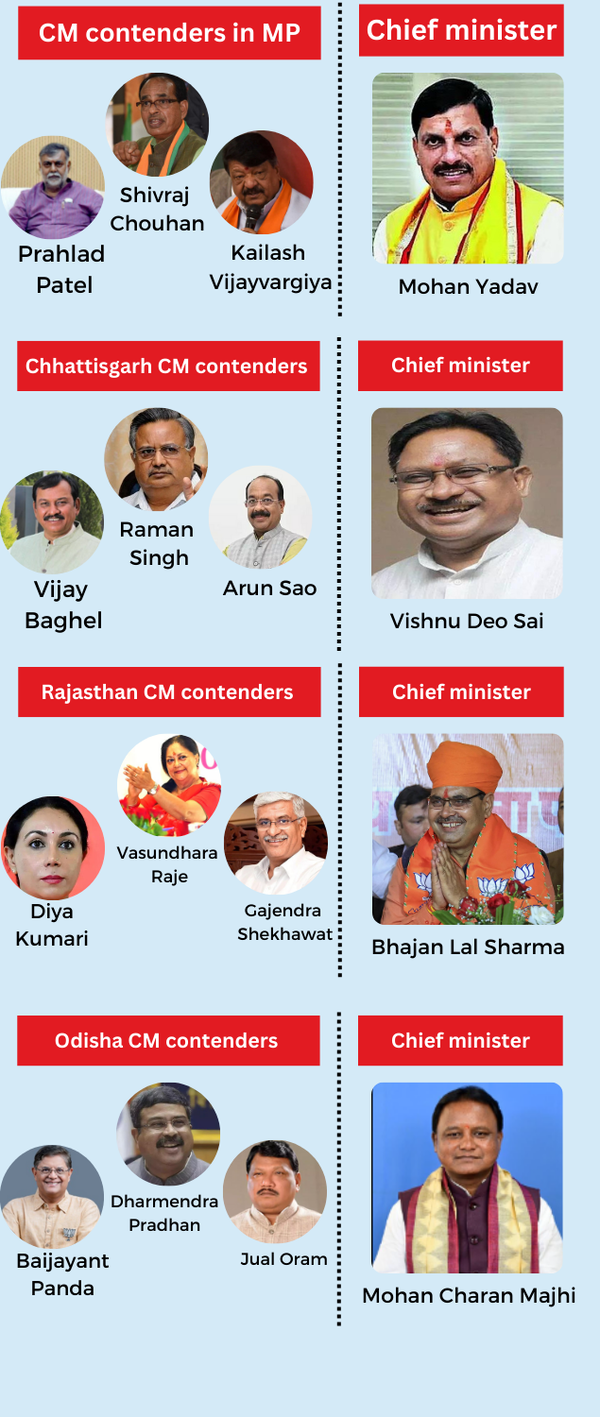NEW DELHI: The Bharatiya Janata Party (BJP), on several occasions, has given reasons to believe that it is good to be a first-time MLA in assembly elections. Picking dark horses over front runners has been a consistent strategy by the BJP’s top brass while choosing chief ministerial face in states the party has won, particularly after 2014.
The BJP’s first bet on a first-timer for the chief ministerial post was in 2014 when the party chose Manohar Lal Khattar to serve Haryana as CM.
In 2014, Khattar was a first-time MLA, an unknown face in the state’s politics who had surprised everyone by being handed the top post after BJP won 47 seats in the assembly election.
Associated with the Rashtriya Swamsevak Sangh (RSS) for over four decades and BJP for 20 years, Khattar had worked as the organising secretary of BJP in Haryana and established his reputation as a key strategist for the party in the state.
Khattar had worked closely with the PM when the latter was BJP in charge of Haryana in 1996. When Modi was contesting from Varanasi in the 2014 general elections, Khattar was in charge of 50 wards in the constituency.
His ability to align and consolidate the non-Jat voters in favour of the BJP endeared him to the party even as the Jat community, which dominated the Haryana politics for a long period, strongly resented the BJP for reasons such as farming issues and Jat quota agitation.
Another such surprise move by the party came in 2024 when it picked Bhajan Lal Sharma the chief minister of Rajasthan.
Bhajan Lal Sharma, a general secretary in the BJP’s state unit and a first-time MLA from Jaipur’s Sanganer constituency, kept a low profile in the party before his sudden rise to the top post.
Interestingly, when a group photo was taken at the BJP office ahead of the legislature party meeting, the photo showed Bhajan Lal Sharma in the very last row. However, during the Rajasthan legislature party meet Bhajan Lal was announced as the leader.
Considered a hardcore RSS man, Sharma was actively involved in the agitation for the Ram temple in Ayodhya at the site where the Babri mosque stood. In 1992, he spent time in jail for this. That was around the beginning of his political career. Over the past 30 years, Sharma had held various posts in the Bharatiya Janata Yuva Morcha (BJYM) and in the party organisation.
The list of first-timers becoming CM only got longer on Wednesday when the BJP’s top leadership backed Rekha Gupta for the Delhi CM post over Parvesh Verma who defeated Ex-Delhi CM Kejriwal in assembly elections.
Rekha Gupta rose through the ranks of the RSS-affiliated outfit Akhil Bharatiya Vidyarthi Parishad. She has held key positions in government and the party.
Gupta’s political journey began in DUSU, in which she served as secretary in 1995-96, before winning the president’s post in 1996-97 as an ABVP candidate. Her trajectory mirrors BJP’s strategy of grooming leaders from grassroots movements.

In a political purge that was seen as BJP’s most audacious experiment, the party in 2021 replaced all 22 ministers from the erstwhile Vijay Rupani cabinet. The tsunami of transformation capped a frenetic six days for the state, starting with Rupani’s sudden resignation as CM. More surprising was the elevation of first-time MLA Bhupendra Patel to the chief ministership.
Unanimously elected as the BJP legislature party leader, Bhupendra Patel made his way up in the state politics from the municipality level. His name was floated by outgoing CM Vijay Rupani himself.
Fondly called ‘Dada’ by many, Patel (59) had contested his maiden assembly election from Ghatlodia constituency in Ahmedabad in 2017 and won it by a margin of over 1.17 lakh votes, which was a record during that election.
BJP’s move to pick CM face is not restricted to only MLAs, the party gave top post responsibility to Yogi Adityanath, who was MP from Gorakhpur, to serve as Uttar Pradesh CM in 2017.
When it comes to selecting chief ministers, the BJP’s script has been the same – state after state. Madhya Pradesh, Chhattisgarh, Rajasthan, Odisha, Gujarat, Haryana – all these BJP-ruled states have chief ministers who were relatively unknown figures in the party till they were picked to lead the state.
The heavyweights and the frontrunners in these states lost the race to the top post. This also helps the BJP in delivering the message that a grassroots leader with an apolitical backdrop can reach the helm of electoral politics.
